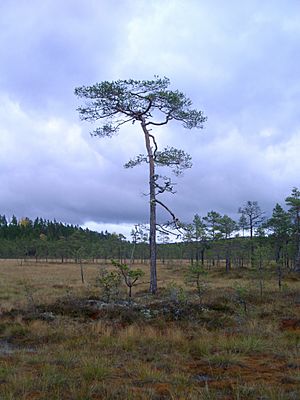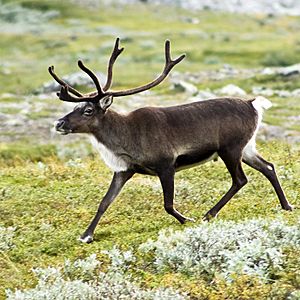Wildlife of Sweden facts for kids
The wildlife of Sweden is super diverse! It includes all the different plants and animals that live in Sweden. This country has a long coastline and many different places for animals and plants to live, like mountains, hills, tundras, forests, rivers, lakes, and farms. Even though Sweden is far north, its climate is usually quite mild.
Contents
Sweden's Landscape
Sweden is a long country located east of Norway and the Scandinavian Mountains. To its west are the Baltic Sea and the Gulf of Bothnia. It stretches from about 55°N all the way up past 70°N, which is north of the Arctic Circle!
The coastline of Sweden has many small islands. There are also two bigger islands in the Baltic Sea called Gotland and Öland. To the southwest, you'll find the Skagerrak and Kattegat seas. To the northeast, Sweden shares a land border with Finland.
Most of Sweden is covered by forests, about 69% of the country! Only 8% of the land is used for farming.
Different Regions of Sweden
- Northern and Central Sweden: This area is called the Norrland terrain. It has lots of hills and mountains covered in boreal forests. These are forests with trees like pine and spruce.
- Central Swedish Lowland: South and east of the Norrland terrain, this area used to have many broad-leaved forests. Now, much of it has been cleared for farming. You'll find some very large lakes here. The soil is good for agriculture, but in hilly spots, the soil is thinner. Here, you'll see Scots pine and Norway spruce trees.
- South Swedish Highlands: South of the lowland, the land rises to the South Swedish highlands. This area has long hills and flat lands, mostly covered by broadleaf forests. It's the part of Sweden with the most different kinds of plants and animals, meaning it has great biodiversity.
Sweden's Climate
Even though Sweden is far north, most of it has a mild climate without big temperature changes.
Climate Zones
Sweden can be split into three climate zones:
- Northernmost part: Has a subarctic climate, which means cold winters and short, cool summers.
- Central part: Has a humid continental climate, with warm summers and cold winters.
- Southernmost part: Has an oceanic climate, which is milder with less extreme temperatures.
Sweden is much warmer and drier than other places at the same latitude. This is mainly because of the Gulf Stream, a warm ocean current, and the usual westerly winds. The northern half of the country gets less rain than Norway because of something called the rain shadow effect. This happens when the Scandinavian Mountains block rain clouds.
Sweden's Biodiversity
Sweden is home to an amazing variety of life! Scientists estimate there are about 50,000 different species of animals and plants living on land in Sweden. This is about 32% of all the species found in Europe!
This includes:
- 73 kinds of mammals
- 6 kinds of reptiles
- 12 kinds of amphibians
- 56 kinds of freshwater fish
- 372 kinds of vascular plants (plants with roots, stems, and leaves)
Plants of Sweden (Flora)
Sweden's plant life changes a lot from south to north, and also depending on the type of land.
Southern Forests
The very south of Sweden, especially Skåne and a strip along the west coast, is a "nemoral zone." Here, the dominant tree is the beech (Fagus sylvatica). In these forests, many small plants like Anemone and Corydalis grow and flower in spring. They do this before the beech trees grow their dense leaves, which would block out the sunlight. Oak (Quercus robur and Quercus petraea) forests grow in poorer soils. You might also find alder, ash, and elm trees in rich, wet soils, but many of these areas have been turned into farms.
Conifer Forests (Boreal Zone)
Most of Sweden, below the mountains, is covered by conifer forests. These are part of the "circumboreal zone," which means they stretch around the northern parts of the world.
- South of River Dalälven: This area is called "boreo-nemoral." You'll find scattered deciduous trees like oak mixed in with the conifers.
- North of River Dalälven: This is the true boreal (taiga) zone. Deciduous trees are rarer here, but birches (Betula pubescens and Betula pendula) and aspen (Populus tremula) can grow a lot after a forest fire or when an area has been recently cut down.
Sweden has four native conifer trees. Only Norway spruce (Picea abies) and Scots pine (Pinus sylvestris) form large forests, either by themselves or mixed together. Spruce usually grows in wetter places, and pine in drier spots. In bogs, you often see many small, stunted pines.
Forest Undergrowth
- In spruce forests: The ground is often covered almost entirely by bilberry (Vaccinium myrtillus). In wetter areas, you'll find ferns. In richer parts, you might see herbs like Paris quadrifolia and Actaea spicata, and broad-leaved grasses.
- In pine forests: Lingonberries (Vaccinium vitis-idaea), heather (Calluna vulgaris), and lichens are most common.
Forest fires happen sometimes. They usually kill all the spruce and most of the pines. After a fire, plants like fireweed (Epilobium angustifolium), raspberry (Rubus idaeus), and Geranium bohemicum are among the first to grow back from the ashes.
Mountain Plants
In the mountains, the conifer forests give way to birch trees (Betula pubescens ssp. tortuosa). These birches form the "tree-line," which is the highest point where trees can grow.
- Undergrowth in birch forests: This can vary a lot. In wet and nutrient-rich places, you might see tall herbs like Aconitum septentrionale and Angelica archangelica.
- Above the birch forest: Starting at different heights depending on how far north you are (300–1000 meters), you'll usually find willow-thickets. Above these are alpine heath or meadows. Heaths are dominated by small shrubs like those in the Ericaceae family. Meadows have sedges, rushes, and various herbs like Saxifraga and Dryas octopetala. The Ranunculus glacialis grows at the highest altitudes, often near glaciers.
Wetlands and Lakes
Sweden has huge areas of wetlands. In the south, "raised bogs" are common. These are mostly made of living and dead Sphagnum moss, with scattered small shrubs and sedges. In the north, there are many large "mire" areas that have both fen-like and bog-like parts.
Sweden also has about 90,000 lakes bigger than one hectare!
- Nutrient-poor lakes: Many lakes are clear with few plants, like Lake Vattern.
- Small ponds: Often have brown water and are surrounded by floating mats of bog plants.
- Nutrient-rich lakes: Found mostly in the south. These usually have thick stands of reeds and other plants growing out of the water, as well as plants floating on the surface or growing completely underwater. Famous examples include Tåkern and Hornborgasjön.
Coastal Plants
Sweden's coast is very long, and the conditions change a lot from one end to the other. Near the Norwegian border, it's like the North Atlantic. Near the Finnish border, it's almost subarctic, and the water is much less salty. A special grass called Deschampsia bottnica grows here. It can survive the thick sea ice that forms in winter.
Animals of Sweden (Fauna)

Sweden is home to many different animals, from tiny shrews to large moose!
Mammals
Sweden has many kinds of mammals. Here are some of them:
- Small Mammals: You can find the European hedgehog, European mole, six kinds of shrews, and eighteen kinds of bats. Also, the European rabbit, European hare, and mountain hare live here, along with the Eurasian beaver, red squirrel, brown rat, and about fourteen kinds of smaller rodents.
- Hoofed Animals (Ungulates): These include the wild boar, fallow deer, red deer, elk (also known as moose in North America), roe deer, and reindeer.
- Carnivores (Meat-eaters): Sweden has the brown bear, Eurasian wolf, red fox, and Arctic fox. Other carnivores include the Eurasian lynx, European badger, Eurasian otter, stoat, least weasel, European polecat, European pine marten, and wolverine.
- Marine Mammals: Along the coast, you might see three kinds of seals. About thirteen kinds of whales, dolphins, and porpoises also visit Swedish waters.
Endangered Mammals
The IUCN keeps a "Red List" of animals that are at risk. In Sweden, some mammals are:
- Critically Endangered: Bechstein's bat, common pipistrelle, and Arctic fox.
- Endangered: Barbastelle bat, serotine bat, pond bat, lesser noctule, and the wolf.
- Vulnerable: Eurasian otter, wolverine, harbour seal, harbour porpoise, and Natterer's bat.
Birds
More than 535 different kinds of birds have been seen in Sweden! Many of these are migratory birds. This means they travel long distances between their breeding grounds in the Arctic and their winter homes further south in Europe and Africa. Sweden's lakes, wetlands, and coasts are great places for water birds and seabirds to nest. In the upland regions, you can find birds like the willow ptarmigan, black grouse, western capercaillie, owls, and birds of prey.
Fish, Amphibians, and Reptiles
- Fish: The only fish found only in Sweden is the critically endangered freshwater Coregonus trybomi. It still lives in just one lake.
- Amphibians: Sweden has eleven kinds of frogs and toads, and two kinds of newts.
- Reptiles: There are four kinds of snakes and three kinds of lizards. All amphibians and reptiles in Sweden are protected by law.
Insects
Sweden has many insects, including about 108 kinds of butterflyes, 60 kinds of dragonflyes, and 40 kinds of wood-boring beetles.
Protecting Sweden's Wildlife
Sweden has been working to protect its forests for over thirty years to help keep its many different plants and animals safe. They do this in several ways:
- Small Scale: Leaving some dead and living trees in areas that have been cleared.
- Medium Scale: Keeping parts of forests untouched. About 5% of Sweden's forested land is set aside for conservation.
- Large Scale: Creating big nature reserves to protect large areas that are very important for wildlife.
Climate Change and Wildlife
Climate change is expected to affect Sweden's biodiversity. For example, the "tree-line" (where trees stop growing in the mountains) might move further north and higher up, with forests replacing tundra. As ice melts, more water will flow into wetlands, changing them. If sea levels rise, the Baltic Sea will get more salty water flowing in.
Images for kids




